#phoenician alphabet
Text
Phoenician Alphabet, The First True Alphabet
Phoenician alphabet, the first true alphabet, the ultimate ancestor of most modern scripts like Greek, Latin, Hebrew and Arabic alphabets. It has 22 letters, all consonants (it's actually an abjad) and written from right-to-left horizontally.

The Phoenician alphabet is a direct descendant of the Proto-Sinaitic alphabet. Developed by the Phoenicians and thanks to their trade especially maritime trade, it spread across West Asia and Mediterranean, making it the most widely used alphabet at that time.
Maybe this is subjective but this alphabet has a big influence, especially two of its derivative variants, Greek and Aramaic. Its simplicity makes it easy to learn and widely adapted. It's the most well-known and valuable heritage of the Phoenicians, thanks to them.
The Greeks modified the Phoenician alphabet, especially by adding vowels, thus creating the Greek alphabet. The Etruscans modified the Greek alphabet (specifically the Euboean Greek alphabet) and creating Etruscan alphabet which is the direct ancestor of Latin alphabet.
The earliest inscriptions of this alphabet date from around the 12th or 11th century BCE. Many come from Byblos, Lebanon and Carthage. This was used to write Phoenician, Punic, Old Aramaic, Ammonite, Moabite, Edomite, Hebrew and Old Arabic.
The use of the Phoenician alphabet proper (the original alphabet, not modified) began to disappear in the 1st century BCE especially after the destruction of Carthage. Derivatives of this alphabet elsewhere at that time were used by many languages.
In the photo I wrote the Phoenician alphabet on paper along with the names of the letters and their transcription. Sorry if the writing seems stiff. Again, thanks to Phoenicians for this.
Taken on Saturday, 24 February, 2024 at 02:37 with Samsung Galaxy A10s.
#sofiaflorina#phoenicians#phoenician alphabet#alphabet#writing system#linguistics#linguistic studies#linguistics tag#historical linguistics#language#languages#history#greek#latin#hebrew#aramaic#arabic#carthage#proto sinaitic#greeks#etruscan#polyglot#polyglots#language learner#language stuff#language learning#langblog#langblr#langbr#language blog
11 notes
·
View notes
Text
The Evolution of the Alphabet: A Story of Human Ingenuity and Innovation 🤯
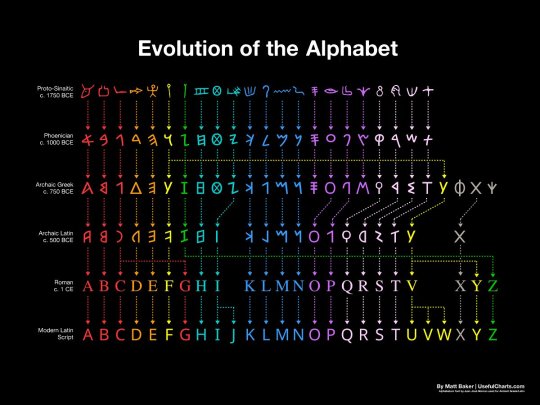
How the Alphabet Changed the World: A 3,800-Year Journey
The evolution of the alphabet over 3,800 years is a long and complex story. It begins with the ancient Egyptian hieroglyphs, which were a complex system of pictograms and ideograms that could be used to represent words, sounds, or concepts. Over time, the hieroglyphs were simplified and adapted to represent only sounds, resulting in the first true alphabets.
The first alphabets were developed in the Middle East, and the Phoenician alphabet is considered to be the direct ancestor of the Latin alphabet. The Phoenician alphabet had 22 letters, each of which represented a single consonant sound. This was a major breakthrough, as it made it much easier to write and read.
The Phoenician alphabet was adopted by the Greeks, who added vowels to the system. The Greek alphabet was then adopted by the Romans, who made some further changes to the letters. The Latin alphabet, as we know it today, is essentially the same as the Roman alphabet, with a few minor modifications.
The English alphabet is derived from the Latin alphabet, but it has undergone some further changes over the centuries. For example, the letters "J" and "U" were added to the English alphabet in the Middle Ages, and the letter "W" was added in the 16th century.
The evolution of the alphabet has had a profound impact on human history. It has made it possible to record and transmit knowledge, ideas, and stories from one generation to the next. It has also helped to facilitate communication and trade between different cultures.
The alphabets are a fascinating invention that have revolutionized the way humans communicate and record information. The history of the alphabets spans over 3,800 years, tracing its origins from the ancient Egyptian hieroglyphs to the modern English letters.

Here is a brief overview of how the alphabets have evolved over time:
Egyptian hieroglyphs (c. 3200 BC): The earliest form of writing was the pictographic system, which used symbols to represent objects or concepts. The ancient Egyptians developed a complex system of hieroglyphs, which combined pictograms, ideograms, and phonograms to write their language. Hieroglyphs were mainly used for religious and monumental purposes, and were carved on stone, wood, or metal.
Proto-Sinaitic script (c. 1750 BC): Around 2000 BCE, a group of Semitic workers in Egypt adapted some of the hieroglyphs to create a simpler and more flexible writing system that could represent the sounds of their language. This was the first consonantal alphabet, or abjad, which used symbols to write only consonants, leaving the vowels to be inferred by the reader. This alphabet is also known as the Proto-Sinaitic script, because it was discovered in the Sinai Peninsula.
Phoenician alphabet (c. 1000 BC): A consonantal alphabet with 22 letters, each of which represented a single consonant sound. The Proto-Sinaitic script spread to other regions through trade and migration, and gave rise to several variants, such as the Phoenician, Aramaic, Hebrew, and South Arabian alphabets. These alphabets were used by various Semitic peoples to write their languages, and were also adopted and modified by other cultures, such as the Greeks, Etruscans, and Romans.
Greek alphabet (c. 750 BC): The Greek alphabet was the first to introduce symbols for vowels, making it a true alphabet that could represent any sound in the language. The Greek alphabet was derived from the Phoenician alphabet around the 8th century BCE, and added new letters for vowel sounds that were not present in Phoenician. The Greek alphabet also introduced different forms of writing, such as uppercase and lowercase letters, and various styles, such as cursive and uncial.
Latin alphabet (c. 500 BC): The Latin alphabet was derived from the Etruscan alphabet, which was itself derived from the Greek alphabet.
Roman alphabet (c. 1 CE): The Roman alphabet is essentially the same as the Latin alphabet, as we know it today. The Latin alphabet was used by the Romans to write their language, Latin, and became the dominant writing system in Europe after the fall of the Roman Empire. The Latin alphabet was also adapted to write many other languages, such as Germanic, Celtic, Slavic, and Romance languages.
English alphabet (c. 500 AD): The English alphabet is derived from the Latin alphabet, but it has undergone some further changes over the centuries. For example, the letters "J" and "U" were added to the English alphabet in the Middle Ages, and the letter "W" was added in the 16th century. The English alphabet consists of 26 letters, but can represent more than 40 sounds with various combinations and diacritics. The English alphabet has also undergone many changes in spelling, pronunciation, and usage throughout its history.
The evolution of the alphabet is a remarkable example of human creativity and innovation that have enabled us to express ourselves in diverse and powerful ways. It is also a testament to our cultural diversity and interconnectedness, as it reflects the influences and interactions of different peoples and languages across time and space.
Thank you for reading! I hope you enjoyed the post about the evolution of the alphabet. If you did, please share it with your friends and family. 😊🙏
#evolution of the alphabet#history of writing#alphabet#hieroglyphs#proto-sinaitic script#phoenician alphabet#greek alphabet#roman alphabet#english alphabet#language#linguistics#consonantal alphabet#syllabic alphabet#ancient egyptian#greek mythology
12 notes
·
View notes
Text



Gift Bag - Wine
Dimensions: 4.75” l x 4” w x 13” h
Perfect size for a wine bottle
Made with premium quality paper for extra durability
Choice of matte or glossy finish
Available in 3 additional sizes
#wine#gift bag#bag#paper bag#phoenician alphabet#phoenician#history#pattern#writing#archaeology#gifts#gifting season#gift ideas#packaging#zazzle store#online store#customizable paper bags#customizable gift bags
0 notes
Text

ngl the terra symbol goes hard but it feels like it’s user by underground neo-nazi groups in karlsruhe tbf
1 note
·
View note
Text
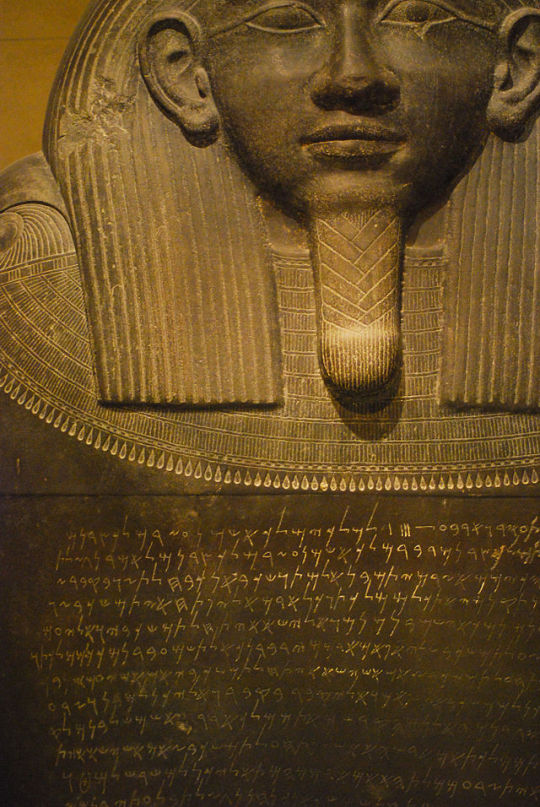
The sarcophagus of Eshmunazar II with what is believed to be a Phoenician Coelbren alphabet. Photo: Eric Chan.
50 notes
·
View notes
Text
The Greeks:can we please copy your homework?
The Phoenicians: okay, but don't make it obvious
The Greeks:
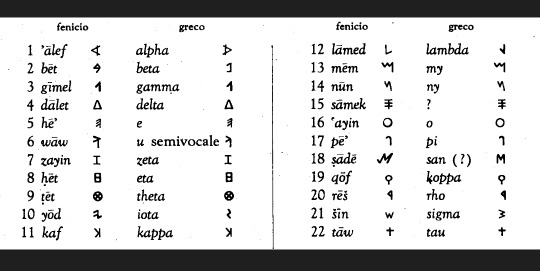
139 notes
·
View notes
Note
treat! 🎃
The practice of putting the alphabet in order goes all the way back to the Phoenician alphabet, which is one of the Latin alphabet's oldest ancestors! Some remnants of the order can still be seen, despite the baggage of several languages and over 3000 years!
ʔbgdhwzḥṭyklmnsʕpṣqršt
Notice b and d in the same location, and the sequences klmn and qršt! The vowels a, e, i, and o come from the letters for ʔ, h, y, and ʕ respectively, and you can see they held on to their places as well
#original broth#language#the order of the Phoenician alphabet is easy for me to remember because hebrew essentially still uses it#if you wanna learn about where the differences come from well. rb asking to learn about where the differences come from <3
5 notes
·
View notes
Text

This could certainly be a coincidence, but in my endless obsession with ancient writing systems (the 900,000 that descend from Phoenician in particular 😄) I just stumbled upon this obscure, archaic form of the Greek letter Beta that, to me, bears a strong resemblance to the rune called Perþō in Old Norse and Peorð in Old English (ᛈ).
It was used in the city of Argos (which is the origin of the dynasty of which Alexander the Great was part, and is the oldest continuously inhabited city in Europe.)
Yes, Beta is /b/ and Perþō and Peorð are /p/, but the Phoenician alphabet, from which all the Greek and runic alphabets descend, didn't didn't distinguish between /b/ and /p/.
The earliest attested appearance of ᛈ is from ~400 AD. In 267 AD Argos was one of several cities sacked by "marauding bands of Goths and Heruli (both Germanic tribes)" so the possibility of a connection between ᛈ and this Beta does exist.
#ancient writing systems#ancient alphabets#runes#futhark#futhorc#greek#greek alphabet#argos#phoenician
12 notes
·
View notes
Text
Being Greek is so funny when someone uses the Greek letters as an “aesthetic” cause they be writing Σ like E when it’s pronounced S and Δ like A when it’s pronounced Th and they have no idea but they write RΣΔD thinking it sounds like “read” actually sounds like RSTHD
#I’m sorry I can’t stand this part of the pjo fandom that pretends to read Greek while reading fake English#and I’m case you’re a nerd like me#here’s a fun fact#ancient Phoenician alphabet -> Ancient Greek alphabet -> Latin -> English#Greek#Greece
4 notes
·
View notes
Text
The Ancient City of Byblos
Byblos is a distinctive tourist destination that combines ancient history, rich culture and the beauty of the natural marine environment.
#travel #traveling #socialsteeze #vacation #visiting #instatravel #instago #instagood #trip #holiday #photooftheday #fun #travelling #tourism #tourist #instapassport #instatraveling #mytravelgram #travelgram #travelingram #igtravel #lebanon #tourism #travelinspiration #travelinspirations #travelbloggers #travelblogger #travelling #vacationmode #Byblos

View On WordPress
#alphabet#Byblos#church#city#history#jbeil#Lebanon#marine#mediterranean#museum#phoenician#roman#roman theater#sea#sea castle#tourism#tourist#touristic#Travel#vacation
1 note
·
View note
Text

my current special interest is the alphabet
here is a letter, for example
#mostly my special interest is occasionally on-and-off writing in phoenician as a cypher#but I figured may as well do a deep dive on an individual letter#it pleases me to find words I can actually translate so several of my favorite melek have been provided#linguistics#alphabet
1 note
·
View note
Text
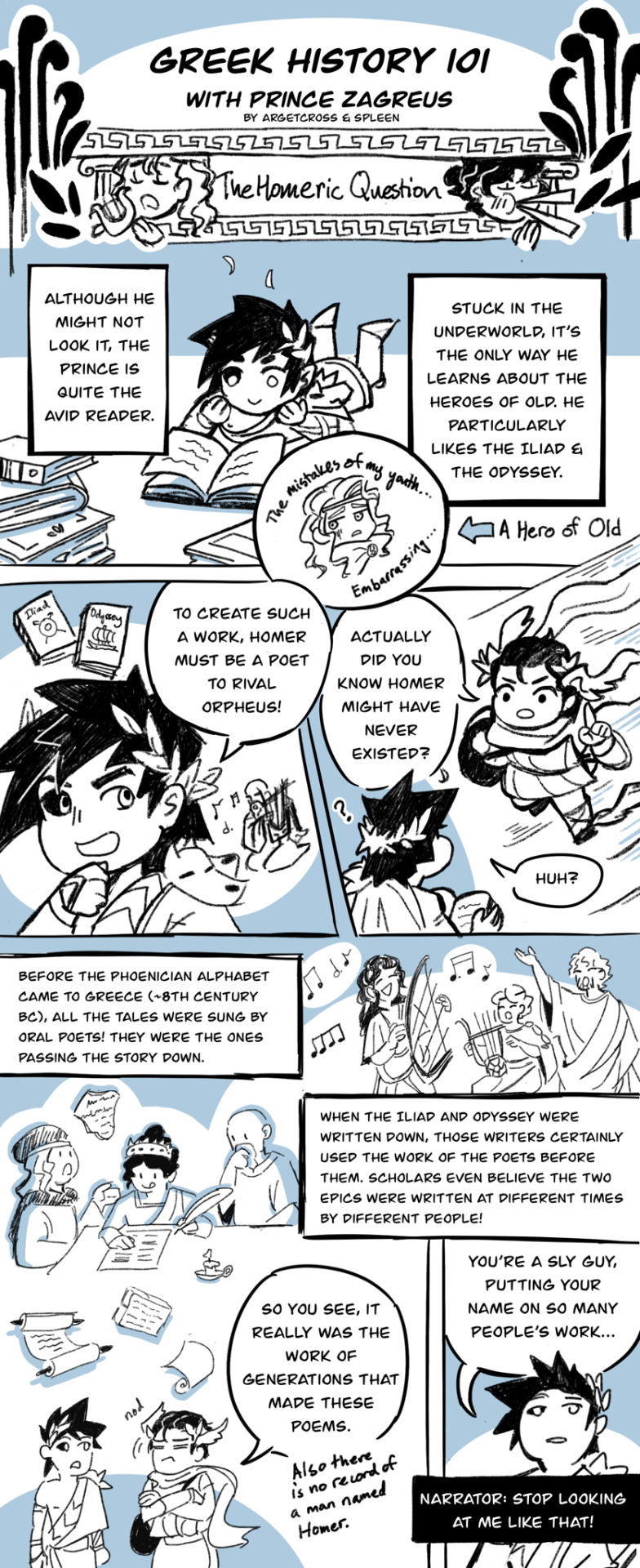
The Homeric Question feat. Prince Zagreus
For further reading, please check out Martin West's "The Homeric Question Today".
Additional caveats and comic text after the cut:
Additional Caveats:
Writing in Greece existed during the Bronze Age in the form of Linear B (and other systems such as Linear A on Minoan Crete), but after the subsequent collapse of Bronze Age civilization, the system disappeared from Greece.
The first mention of Homer as the author of both poems comes from comes from 520 BCE, a century or more after the poems were created. Prior to this, there was much debate even in ancient times as to the poems' origins, some citing different authors, others saying the creators were anonymous.
Comic Text:
Title: Greek History 101 with Prince Zagreus
Subtitle: The Homeric Question
Written and drawn by Argetcross. Colors by Spleen.
[Panel 1]
NARRATION: Although he might not look it, the Prince is quite the avid reader.
NARRATION: Stuck in the Underworld, it's the only way he learns about the heroes of old. He particularly likes the Iliad and the Odyssey.
TEXT AROUND ACHILLES: The mistakes of my youth.... Embarrassing (<- A Hero of Old)
[Panel 2]
ZAGREUS: To create such a work, Homer must be a poet to rival Orpheus!
[Panel 3]
HERMES: Actually did you know Homer might have never existed?
ZAGREUS: Huh?
[Panel 4]
NARRATION (HERMES): Before the Phoenician alphabet came to Greece (~8th century BC), all the tales were sung by oral poets! They were the ones passing the story down.
NARRATION (HERMES): When the Iliad and Odyssey were written down, those writers certainly used the work of the poets before them. Scholars even believe the two epics were written at different times by different people!
HERMES: So you see, it really was the work of generations that made these poems. (Also there is no record of a man named Homer.)
[Panel 5]
ZAGREUS: You're a sly guy, putting your name on so many people's work...
(IN-GAME) NARRATOR: Stop looking at me like that!
#hades game#homeric epics#zagreus#hermes#ancient greece#greek mythology#the homeric question#the iliad#the odyssey#my art#fan comic#ancient history#ancient greek literature#hello this came to me in a dream#i now inflict it upon you#please read the paper it's so funny and good
200 notes
·
View notes
Text
A Linguistic Analysis of the Spelling Names "Ania" and "Anya" (and the chapter and languages of Ostania)
This includes spoilers from Short Mission 11, or Chapter 90.1
It's not a secret that Anya's (Ania) name change was officialized along with Loid (Lloyd) and Yor (Yoru/Yolanda) in July 2019. I do recall that our loveable Forger family had different spellings in the early manga releases. Many believed that it was Endo-san's way to cover up the spelling mistake, but I believe that, whether or not the origin and/or intention was a mistake, it paved a beautiful opportunity for a deep dive into linguistics and character analysis on Anya Forger.
First, I'd like to address my thoughts on "ANIA" as the spelling. Here are a few of my impressions on this:
"ANIA" could be perceived as her original spelling because wherever she came from used this spelling.
"ANIA" could just be her limitation as a child when it came to spelling her name.
"ANIA" could be an acronym from her lab that probably served the purpose of her existence.
"ANIA" could be the name of her mother/creator. And she was subjected to share the same name of her creator for "sourcing" purposes.
"ANIA" when applied to numerology number, reinforced her code name which is 007 (which is super meta to me, but probably is a coincidence because we all know 007 was Endo's way of referencing James Bond). S/O to @momentocollector for sharing this!

Second, I'd like to address "ANIA" as an identity for our precious baby girl.

"Ania" is the chosen spelling. This could possibly mean that this is her real name and how it should be spelled (You, as the owner of your name have every right to decide what your name should be, spelled, or pronounced after all).
"Ania" could possibly be an influence of either her mother-tongue language's spelling.
"Ania" could possibly be due to her limitation of spelling. (I don't think she is aware of how her name should be spelled.)
Recall that Yor carved out Anya's name as "Ania" and didn't question it. This could be a reflection of Yor's own lack of familiarity of Ostanian orthography since she is academically limited, and she would have listened to how Anya would have wanted her name to be spelled. Furthermore, this tells me that Yor's absence of questioning reflects that she accepts her daughter no matter who she is, be it "Ania" or "Anya".
Third, I'd like to address "ANYA" as her name's spelling.

"A-N-Y-A" is the spelling that her papa gave her, which tells her that she can now be on the same playing field as her parents. Their names and titles are all "masks" in this masquerade that they call "Forger". So, to little Anya, it means that she finally belongs with someone. Anya has essentially found "her home".
We also know that Franky did do a lot of paperwork and found that "Anya" is the spelling that was written down on her adoption papers. This reinforces that "Anya" is the standard Ostanian orthography of her name.
I perceive Loid as a person replicating the "average Ostanian" (since this is a deep cover mission after all), so to also tell her that her name is spelled a certain way reinforces that she has a new identity as an "Ostanian child". (I find this quite ironically poetic because it's a "fake man" giving a "fake name" to his "fake daughter").
I also see that when Anya's eyes light up, it could also mean that this new identity in her spelling change meant she was finally liberated from her days as a lab experiment and living in an orphanage.

Fourth, I'd like to address spelling etymology.
Since I'm not a Japanese linguist expert, I found @connoisseursdecomfort post to be quite educational when it came to Japanese spelling.
What we learn from the above post is that "Ania" is an acceptable name spelling in "Old Japanese". But as time progressed, the spelling changed to "Anya" which is the modern-day spelling of this name (this may tie into Anya's character lore).
We can track "i" becomes "y" in the evolution of the alphabet from Phoenician (c. 1000 BC) to Archaeic Greek (c. 750 BC). S/O to @rachellysebrook for this link. (Again, what this reinforces is Anya's background with an unidentified mother country/mother tongue language).
Another thing is that Yor Forger did not react to the spelling of "Ania". It could possibly be that she recognized Anya's limitation, given that her daughter already had poor scores since her admission.
We also learned that Yor, a real Ostanian, seems to be limited with Ostanian orthography which is most likely due to her dropping out of school to take care of Yuri (fake Ostanian /j). From her interaction with Anya, off-screen, it appears that Yor seems indifferent to spelling standards of names (Which is nice! She is subtly against society's norm and I love her for that). Had she been aware of the spelling, she would have been the one to ask instead of Loid. (But again, it must be Loid because it's poetic and has a much more meaningful interaction between "Loid" and "Anya").
Fifth, I'd like to address the name's (possible) impact on character purpose in the story.
"Anya" means mother in Hungarian (S/O to @httplovecraft1890. This inspired my thoughts on "Ania" as a name in the lab). Could this possibly be an inspiration or coincidence? It could be a stretch, but perhaps Anya's purpose in the lab is that she's a "mother weapon" for war.
"Ania" means "gracious" and "merciful" according to Google. Which makes me think that the lab scientists went with this name because it would represent her purpose as a weapon of war. Perhaps Ania becomes the "truth serum" and could be seen as the "angel of death" because she knows the war captor's thoughts and inevitably they are executed (a possible headcanon).
Sixth, I'd like to discuss the factors of the mysterious "unidentified language".
Anya did use "oui" in the anime when Loid had adopted her. This automatically made me think her possible origins could be French, but it could also take another step back in the language family: Romance. What makes this work is that we treat "Classical Language" as a dead language based on what we read/saw in the manga/anime like Latin. Anya has an innate potential to be bi-/multilingual.

Bonus: Seventh, I'd like to talk about the languages in this anime (This is a bit of a ramble but since we're talking about linguistics, I thought why not)...
Based on the dialogues spoken in the anime, we can confirm that English exclamatory (Oh my God, Goddammit, Shit, Wow, Elegant, etc.) and the Japanese language are the main components of the Ostanian language. This is reinforced by many characters who have used English expressions (Loid, Yuri, Yor, Anya, Damian, Henderson, etc.)

What does bug me is whether or not "oui", a French exclamatory, should be categorized as part of the Ostanian language or if that should be categorized for Anya's hidden lore. The reason is that when Loid/Twilight heard Anya say "oui" in front of him, he did not question it. (Perhaps he was too tired to process this, or he excused it as something Anya could have seen on TV and is merely mimicking. I really don't think Twilight would be the type to excuse this realization had he not had the aforementioned state of mind). I'm leaning more towards the latter as this is from Anya's mother tongue language.
In conclusion (or tldr;): "Ania" may be her real name, but "Anya" is her new identity as part of the Forgers.
If you read everything, thank you for your time! The linguist in me is so happy that Endo-san is steeping his foot into linguistic territory. As short as this chapter was, it said A LOT to me linguistically and provided more details to the scraps of lore that we know of Anya but it also tells us a bit more about Yor, Loid/Twilight, and Ostania.
#spy x family#spy x family spoiler#spy x family chapter 90.1#Anya Forger#Ania#Anya#name analysis#manga chapter analysis#analysis#Spy x family Analysis#linguistics#orthography#loid forger#yor forger#scarlymadeathing#scarlydidathing#scarlywroteathing
249 notes
·
View notes
Text


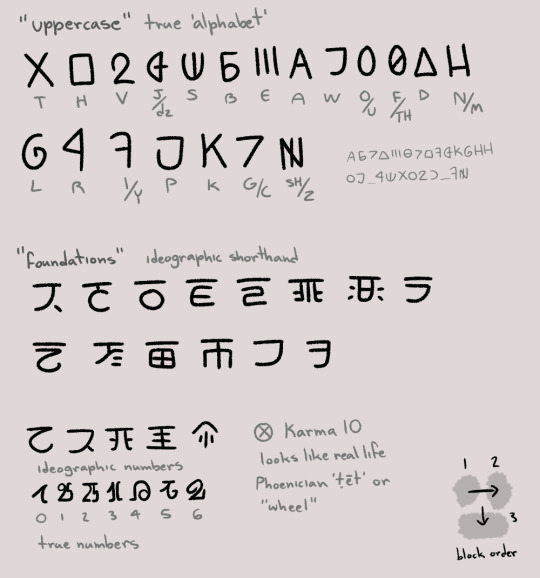
i wanted to make my own rain world script for my own reference and so this is all made up and not an actual glyph analysis, just a script inspired by it
nerd ramble below the cut, if tumblr ACTUALLY formats properly
i conclude that there are both an alphabet and an ideographic script. in game the ideographs always stand alone or serve as a base. kinda like kanji—the ideographs represent whole words and concepts.
I chose the sounds of the alphabet based on cyrillic, greek, phoenician. generally following what the evolution of most writing systems suggest.
i dont think the karma symbols meant numbers initially, but later on they became interchangeable. im more curious about the base six system the guardians use!
485 notes
·
View notes
Text
Another cool little fact: Karma 10's symbol (𐤈) is identical to the letter "teth" in Phoenician alphabet.

Although it's pretty much unrelated to it's meaning in rain world. This symbol is originally supposed to represent a wheel, it originates from the Proto-Canaanite symbol of teth.
Another cool coincidence appear at the icon of the steam achievement A Helping Hand. The base of the symbol resembles the letter "yod". And like the letter "teth" it has it's own meaning, and quite a fitting one. It's meaning is literally an arm or an hand.


I have more examples to show, but I think you understand the point. Funny video game symbols are similar to letters found in an ancient alphabet.
And I don't think these are deliberately based on these letters, but it's just another cool excuse to like rain world a little more.
137 notes
·
View notes
Text
kids these days aren't learning cursive :( kids these days aren't learning humanistic script :( kids these days aren't learning cursiva anglicana :( kids these days aren't learning protogothic :( kids these days aren't learning caroline minuscule :( kids these days aren't learning rustic capitals :( kids these days aren't learning the etruscan alphabet :( kids these days aren't learning the phoenician abjad :(
632 notes
·
View notes